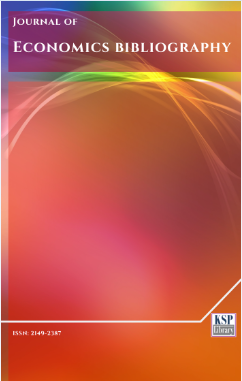Smile curve and its linkages with global value chains
Abstract
Abstract. The concept and logic of ‘smile curve’ in the context of global value chains has gained importance in recent time period and discussed at the individual firm level, but rarely identified and investigated at the sectoral level using real data for cross-country analysis. Using TIVA database for 2001 and 2011 time period, several conceptual value chain are investigated including exports of Base Metals, Computer Electronics, Electrical Machinery and Transportation equipment’s in Asian Economies. This paper focuses an idea to measure both the strength and linkages between producers and consumers of global value chain. The identified smile curve provides a very intuitive understanding of the roles played by different countries in various sectors and helps in identifying the benefits gained by them through their participation in global trade. The dynamics of structural upgrading and interactive growth via trade and investment within a hierarchy of countries is aligned with “flying-geese (FG)” theory of growth. The paper also gives emphasis on the role of Regional Comprehensive Economic Partnership in broadening economic integration.
Keywords. Economic integration, Fragmentation, Globalization.
JEL. F60, F12, F15.Keywords
References
Akamatsu, K. (1961). A theory of unbalanced growth in the world economy, WelwirtschaftlichesArchiv, 86(2), 192-215.
Arndt, S. (1997). Globalization and the open economy, The North American Journal of Economics and Finance, 8(1), 71-79. doi. 10.1016/S1062-9408(97)90020-6
Baldwin, R. (2011). Trade and industrialization after globalization’s 2ndUnbundling: How Building and Joining a Supply Chain are different and Why It Matters, NBER Working Papers, No.17716. doi. 10.3386/w17716
Baldwin, R., Ito T., & Sato, H. (2014). The smile curve: Evolving sources of value added in manufacturing, Joint Research Program Series, IDE-JETRO. [Retrieved from].
Campa, J., & Goldberg, L. (1997). The evolving external orientation of manufacturing industries: Evidence from four countries, NBER Working Paper, No.5919. doi. 10.3386/w5919
Feenstra, R. (1998). Integration of trade and disintegration of production in the global economy, Journal of Economic Perspectives, 12(4), 31-50. doi. 10.1257/jep.12.4.31
Grossman, G., & Helpman, E. (2002a). Outsourcing in a global economy, NBER Working Paper, No.8728. doi. 10.3386/w8728
Grossman, G., & Helpman. E. (2002b). Integration versus outsourcing in industry equilibrium, Quarterly Journal of Economics, 117(1), 85-120. doi. 10.1162/003355302753399454
Grossman, G.M., & Rossi-Hansberg, E. (2008). Trading tasks: A simple theory of offshoring. The American Economic Review, 98(5), 1978-1997. doi. 10.1257/aer.98.5.1978
Hanson, G., Mataloni, R.J., & Slaughter, M.J. (2003). Vertical production networks in multinational firms, NBER Working Paper, No.9723. doi. 10.3386/w9723
Hummels, D., Ishii, J., & Yi, K. (2001). The nature and growth of vertical specialization in world trade, Journal of International Economics, 54(1), 75-96. doi. 10.1016/S0022-1996(00)00093-3
Jones, R., & Kierzkowski, H. (1990). The role of services in production and international trade: A theoretical framework, in R. Jones & A. Krueger, (Eds.), The Political Economy of International Trade, Basil Blackwell, Oxford.
Kawakami, M., & Sturgeon, T.J. (2012). The Dynamics of Local Learning in Global Value Chains: Experiences from East Asia, IDE-JETRO Series, Palgrave Macmillan.
Kowalski, P. et al. (2015). Participation of developing countries in global value chains: Implications for trade and trade-related policies, OECD Trade Policy Papers, No.179. [Retrieved from].
Krugman, P. (1995). Growing world trade: Causes and consequences, Brookings Papers on Economic Activity. [Retrieved from].
Kumar, S., & Ahmed, S. (2015). Gravity model by panel data approach: An empirical application with implications for South Asian countries, Foreign Trade Review, 50(4), 233-249. doi. 10.1177/0015732515598587
Mudambi, R. (2008). Location, control and innovation in knowledge-intensive industries, Journal of Economic Geography, 8(5), 699-725. doi. 10.1093/jeg/lbn024
OECD, WTO and World Bank Group (2014). Global Value Chains: Challenges, Opportunities, and Implications for Policy. Report prepared for submission to the G20 Trade Ministers Meeting. [Retrieved from].
Ozawa, T. (2001). The ‘hidden’ side of the ‘flying-geese’ catch-up model: Japan’s dirigiste institutional setup and a deepening financial morass, Journal of Asian Economics, 12(4), 471-491. doi. 10.1016/S1049-0078(01)00098-7
Pietrobelli, C., & Rabellotti, R. (2010). Global value chains meet innovation systems: Are there learning opportunities for developing countries?, IDB Working Paper Series, No.232. [Retrieved from].
Shin, N., Kraemer, K.L., & Dedrick, J. (2012). Value capture in the global electronics industry: Empirical evidence for the smiling curve concept. Industry and Innovation, 19(2), 89-107. doi. 10.1080/13662716.2012.650883
Shih, S. (1996). Me-Too is not my Style: Challenge Difficulties, Break through Bottlenecks, Create Values (Taipei: The Acer Foundation). [Retrieved from].
UNCTAD, (2013). World Investment Report 2013: Global Value Chains: Investment and Trade for Development, United Nations Conference on Trade and Development, United Nations Publication. [Retrieved from].
United Nations Economic and Social Commission for Asia and the Pacific (2015). Asia-Pacific Trade and Investment Report 2015:Supporting Participation in Value Chains. New York: UNESCAP. [Retrieved from].
United Nations Economic and Social Commission for Asia and the Pacific (2011). Fighting Irrelevance: The Role of Regional Trade Agreements in International Production Networks in Asia’, Asia Pacific Research and Training Network on Trade Study, New York: UNESCAP. [Retrieved from].
World Trade Organization (2011). Trade patterns and global value chains in East Asia: From trade in goods to trade in tasks’, in collaboration with Institute of Developing Economies (IDE) and Japan External Trade Organization (JETRO), Geneva: WTO. [Retrieved from].
Yi, K.M. (2003). Can vertical specialization explain the growth of world trade?. Journal of Political Economy, 111(1), 52-102. doi. 10.1086/344805
DOI: http://dx.doi.org/10.1453/jeb.v4i3.1434
Refbacks
- There are currently no refbacks.
.......................................................................................................................................................................................................................................................................................................................................
Journal of Economics Bibliography - J. Econ. Bib. - JEB - www.kspjournals.org
ISSN: 2149-2387.
Editor: [email protected] Secretarial: [email protected] Istanbul - Turkey.
Copyright © KSP Library

